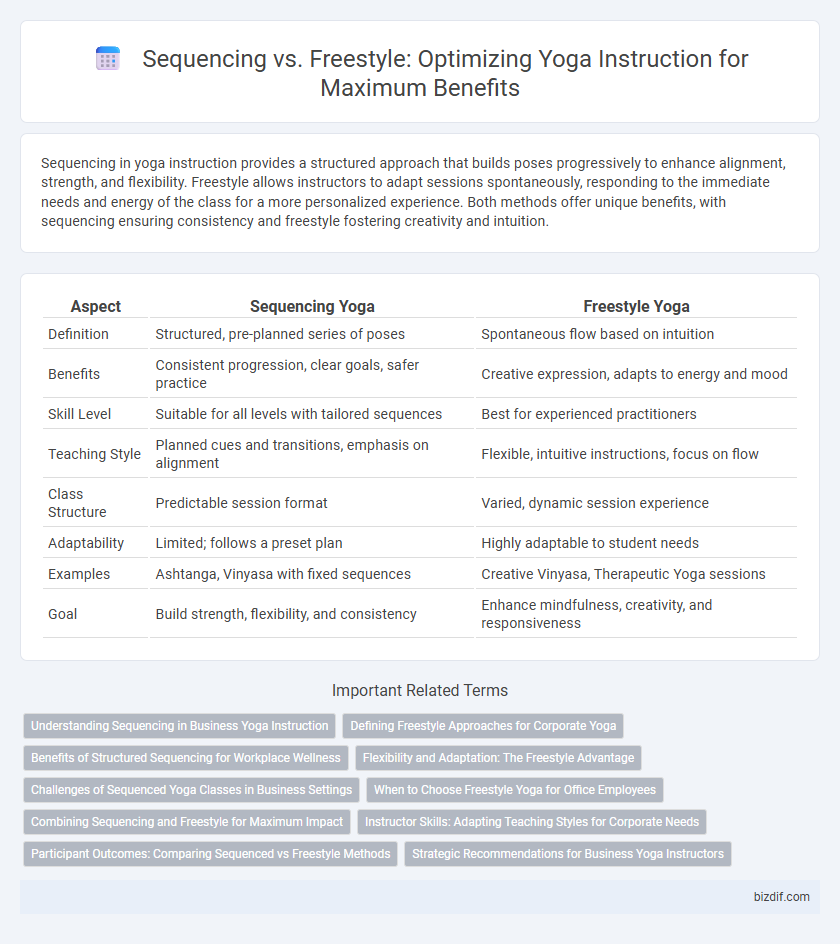Sequencing in yoga instruction provides a structured approach that builds poses progressively to enhance alignment, strength, and flexibility. Freestyle allows instructors to adapt sessions spontaneously, responding to the immediate needs and energy of the class for a more personalized experience. Both methods offer unique benefits, with sequencing ensuring consistency and freestyle fostering creativity and intuition.
Table of Comparison
| Aspect | Sequencing Yoga | Freestyle Yoga |
|---|---|---|
| Definition | Structured, pre-planned series of poses | Spontaneous flow based on intuition |
| Benefits | Consistent progression, clear goals, safer practice | Creative expression, adapts to energy and mood |
| Skill Level | Suitable for all levels with tailored sequences | Best for experienced practitioners |
| Teaching Style | Planned cues and transitions, emphasis on alignment | Flexible, intuitive instructions, focus on flow |
| Class Structure | Predictable session format | Varied, dynamic session experience |
| Adaptability | Limited; follows a preset plan | Highly adaptable to student needs |
| Examples | Ashtanga, Vinyasa with fixed sequences | Creative Vinyasa, Therapeutic Yoga sessions |
| Goal | Build strength, flexibility, and consistency | Enhance mindfulness, creativity, and responsiveness |
Understanding Sequencing in Business Yoga Instruction
Understanding sequencing in business yoga instruction enhances class flow, ensures balanced muscle engagement, and reduces injury risk. Structured sequences help instructors tailor sessions to specific client needs, improving retention and satisfaction. Mastery of sequencing frameworks supports scalable program development and consistent quality delivery.
Defining Freestyle Approaches for Corporate Yoga
Freestyle approaches in corporate yoga prioritize adaptability and responsiveness, allowing instructors to tailor sessions based on participants' energy levels and workplace stressors. This method emphasizes intuitive flow and real-time adjustments rather than predetermined sequences, fostering engagement and mindfulness in busy office environments. Incorporating meditation and breathwork elements enhances the holistic benefits, promoting relaxation and productivity among employees.
Benefits of Structured Sequencing for Workplace Wellness
Structured sequencing in yoga instruction enhances workplace wellness by promoting consistent practice that targets stress relief, improved posture, and increased focus. This method ensures gradual progression in difficulty, reducing injury risk and fostering employee confidence and motivation. Clear sequences create a shared routine that strengthens team cohesion and supports overall mental and physical well-being in the office environment.
Flexibility and Adaptation: The Freestyle Advantage
Freestyle yoga prioritizes flexibility and adaptation by allowing instructors to modify sequences based on students' immediate needs and energy levels, enhancing personalized practice. This approach fosters spontaneous creativity in class flow, accommodating varying abilities and promoting deeper mind-body connection. Emphasizing real-time responsiveness, freestyle instruction supports holistic wellness and sustained engagement over rigid sequencing.
Challenges of Sequenced Yoga Classes in Business Settings
Sequenced yoga classes offer structure and consistency but often struggle to accommodate diverse student needs and varying skill levels in business environments. Inflexible sequencing can limit adaptability, making it difficult for instructors to address individual progress and prevent stagnation, which impacts client retention. Businesses face challenges balancing the demand for predictable scheduling with the need for dynamic, personalized yoga experiences that foster engagement and growth.
When to Choose Freestyle Yoga for Office Employees
Freestyle yoga suits office employees seeking stress relief and personalized movement during breaks, allowing adaptation to individual energy levels and desk-induced tension. This approach encourages spontaneous poses targeting tight areas like the neck, shoulders, and lower back, maximizing workplace wellness. Opting for freestyle supports mental clarity and flexibility without rigid structure, ideal for unpredictable work schedules.
Combining Sequencing and Freestyle for Maximum Impact
Integrating sequencing and freestyle approaches in yoga instruction maximizes practice benefits by balancing structure with creative expression. Sequencing ensures logical progression and alignment while freestyle encourages spontaneity and personal intuition, fostering deeper mind-body connection. This combination enhances adaptability, prevents plateauing, and supports holistic growth in strength, flexibility, and mindfulness.
Instructor Skills: Adapting Teaching Styles for Corporate Needs
Effective yoga instructors tailor sequencing methods to meet corporate clients' goals, emphasizing stress relief and productivity through structured routines. Mastery in transitioning between planned sequences and freestyle adjustments allows facilitators to respond dynamically to participants' energy and skill levels. This adaptability enhances engagement, ensuring sessions align with workplace wellness objectives and diverse employee needs.
Participant Outcomes: Comparing Sequenced vs Freestyle Methods
Sequenced yoga classes enhance participant outcomes by providing structured progression that supports skill development and injury prevention. Freestyle methods offer adaptability, allowing instructors to tailor sessions to individual needs and promote creativity in movement. Research indicates that combining sequenced and freestyle elements can optimize participant engagement and overall well-being.
Strategic Recommendations for Business Yoga Instructors
Structured sequencing in yoga classes enhances student retention by providing consistent progressions and measurable improvements, appealing to clients seeking clear development paths. Incorporating themed sequences aligned with client goals like stress reduction or flexibility maximizes engagement and differentiates the instructor's offerings in competitive markets. Balancing sequenced sessions with occasional freestyle elements encourages creativity while maintaining professionalism, ultimately supporting business growth through client satisfaction and referrals.
Sequencing vs Freestyle Infographic

 bizdif.com
bizdif.com